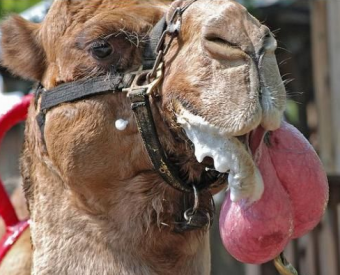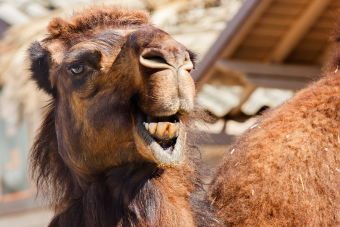The Bizarre Mating Practices of the Arabian Camel
Some people are into feet, others like dressing up in furry costumes, and a rare few will even get scatological (See: Mozart’s Much Less Family Friendly Works). But when it comes to weird sexual practices, it would be difficult to top the mating rituals of the one-humped camel.
Also known as the Arabian camel and dromedary, Camelus dromedarius is found throughout the hot, dry deserts of the Middle East and Africa (with a large wild population still roaming about in Australia as well).
Unlike their two-humped Bactrian cousins (Camelus bactrianus), Arabian camels store fat in a single bump on the back, and its hump can grow to as large as 80 pounds.
Big, dromedaries can be as tall as 6.5 feet at the shoulder and weigh over 1,000 pounds, as well as drink up to 30 gallons of water in under 13 minutes. Unlike other ungulates, their toes aren’t covered by hooves, and their feet are large, broad pads. Their eyes and noses are adapted to a dry, dusty environment, so they have slits for nostrils that can be shut, as well as three sets of eyelids – two with eyelashes to keep dust out, and a third, nictitating membrane, that wipes off the eyeball from the side.
The famous hump is comprised of fat and fibrous tissue, the former of which is metabolized to provide the camel with energy during times of deprivation. Camels have made other adaptions for their dry environments, as well, including rarely sweating, having extremely concentrated urine and exceptionally dry poo, and kidneys and intestines that are good at helping their bodies retain water.
However, of all their adaptations, the grossest is probably the male dromedary’s proclivity to blow up a portion of his soft palate with air to the point that it protrudes up to a foot out of his mouth – as a sign to the ladies that he is hot to trot.
Scientists don’t really know how the camels puff up the diverticulum, but some think that, while exhaling, the males close off the nostrils, forcing the air into the pharynx and soft palate.
 Whatever the case, with large, repugnant sacks hanging out of their mouths, male dromedaries begin the courtship. Using their spit to make a low gurgling sound that results in foaming at the mouth, they also mark their territory by rubbing their necks (where they have poll glands that produce a foul, brown goo) anywhere they can, and even pee on their own tails to attract a lady with their urine’s “female-attracting pheromones“.
Whatever the case, with large, repugnant sacks hanging out of their mouths, male dromedaries begin the courtship. Using their spit to make a low gurgling sound that results in foaming at the mouth, they also mark their territory by rubbing their necks (where they have poll glands that produce a foul, brown goo) anywhere they can, and even pee on their own tails to attract a lady with their urine’s “female-attracting pheromones“.
A dominant male (male camels become mature at about six years) will collect a harem, with anywhere from 10-20 females, but challenges are many. A fight will typically start with low noises, then proceed to various head movements, then biting at each other’s legs, and finally chomping on the opponent’s head with sharp teeth.
This last often results in injuries to the soft, squishy dulaa, which can be still hanging outside of the mouth. In addition to cuts, ulcers and bruises, bits of food can even become lodged in the dulaa, and each malady can lead to bleeding, as well as inflammation and swelling. Each of these can contribute to either an inability to the withdraw the dulaa back into the mouth, or a dulaa that is completely trapped within it.
When these injuries are severe, brave veterinarians must remove it, although first putting the animal under deep sedation. According to one study (Sobayil), most male camels that had their dulaas removed had no decline in sexual desire after the operation (21 out of 26, with no follow-up information provided on 4 subjects).
If you liked this article, you might also enjoy our new popular podcast, The BrainFood Show (iTunes, Spotify, Google Play Music, Feed), as well as:
- Before Mating, the Female Giraffe Will First Urinate in the Male’s Mouth
- Clownfish are All Born Male, a Dominant Male Will Turn Female When the Current Female of the Group Dies
- There is a Type of Duck That Sometimes Lassos its Potential Mates with its Penis
- How Porcupines Mate
- The Male White-Fronted Parrot Vomits in the Female’s Mouth During Their Mating Ritual
Bonus Facts:
- In addition to removing sick dulaas, sometimes healthy dulass are removed – particularly to improve racing performance. Known to impede airflow and breathing, some owners believe removing the dulaa will increase oxygen intake and, thereby, result in a more successful racer. In one study (Kuhad), nearly one-third of the male camels that had their dulaas removed improved their racing times in five-mile races by an estimated 20 seconds.
- Beyond dulaa removal, overall, camel race times have shortened of late. Running at speeds nearing 30 mi/h, today’s camels (which include females who, pre-dulaa excision, are usually faster than the males) on average have have lowered their times by 25% on six-mile (10k) courses over the past 20 years. Although surgical improvements may account for some this, technological advancements no doubt play a part as well. Until quite recently, small immigrant children from impoverished countries were employed as camel jockeys. To keep them light and improve performance, many (with some as young as four years) were kept undernourished, and, of course, they would often be injured (or even killed) as falling off the hump was known to happen. Illegal (not to mention unconscionable), racing camel owners finally replaced the children; but in order to keep the camels’ burdens light, they developed robot jockeys, which have been in use since 2005. Weighing between four and six pounds, the robots sit atop the camels and are equipped with a speaker and remote control, so the owners can direct the racers. At first the robots were built to look like the children, as the owners were concerned that the camels would only accept a child jockey; however, today, they resemble only tiny, primitive dolls after the owners learned that “the camel only needs one hit and then it will run.”
- The ancient Arabian tradition of camel racing
- Arabian (Dromedary) Camel
- Bactrian & Dromedary Camels
- Camels Have Three Eyelids
- Camelus dromedaries (Köhler-Rollefson)
- Dromedary
- Dubai’s Camel Races Embrace Robot Jockeys
- Nictitating membrane
- New Technique for Soft Palatectomy in One-humped Male Racing Camels (Kuhad, et al.)
- Surgery of the Injured Dulaa in Dromedary Camels (Sobayil, et al.)
| Share the Knowledge! |
|






I used to do volunteer work at the Pittsburgh Zoo when I was in high school. I spent ALL of my free waking hours there, of course I had my fave animals. One of those were the camels. I learned a lot whilst working at the zoo. One thing I learned is that male camels do not only blow up their dulaa when sexually excited. They pretty much knew when I would arrive everyday and they would watch for me. When I started walking up that hill and they saw me (they have remarkable eyesight as well) they would run to me to meet me at the fence and they were blowing bubbles and dulla and drooling and gurgling the entire run to the fence! They were excited because they knew when I got there I would feed them leaves from their favorite trees which were out of their reach entirely.
it seems to me, the drooling thing of the dromedaries are triggered by the animals anticipation of the things that might happen,
Camels are disgusting